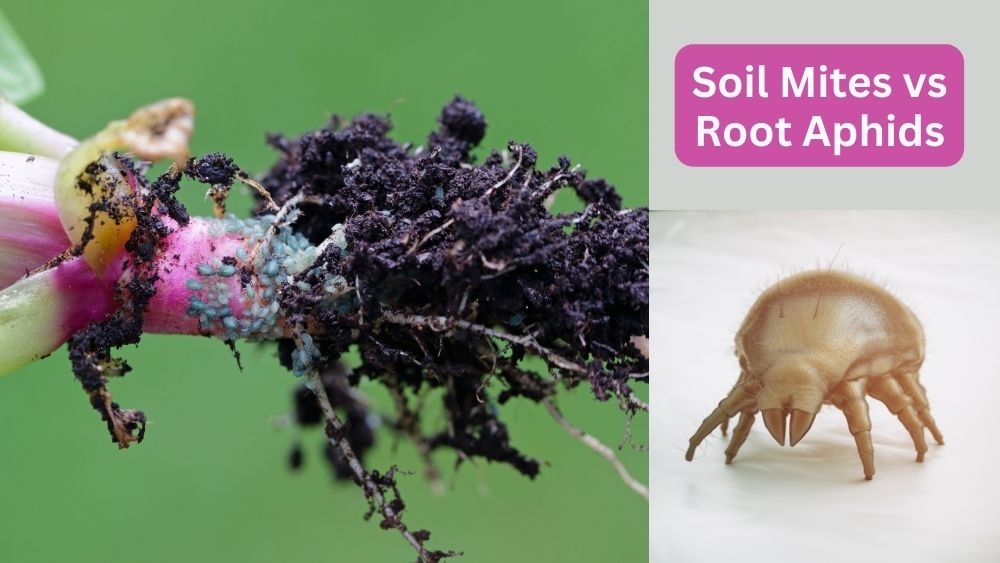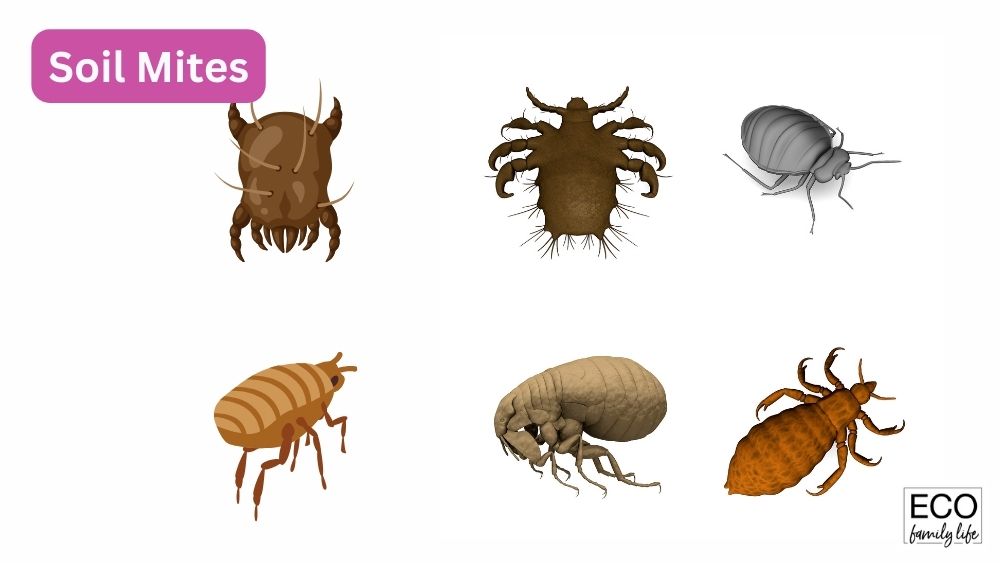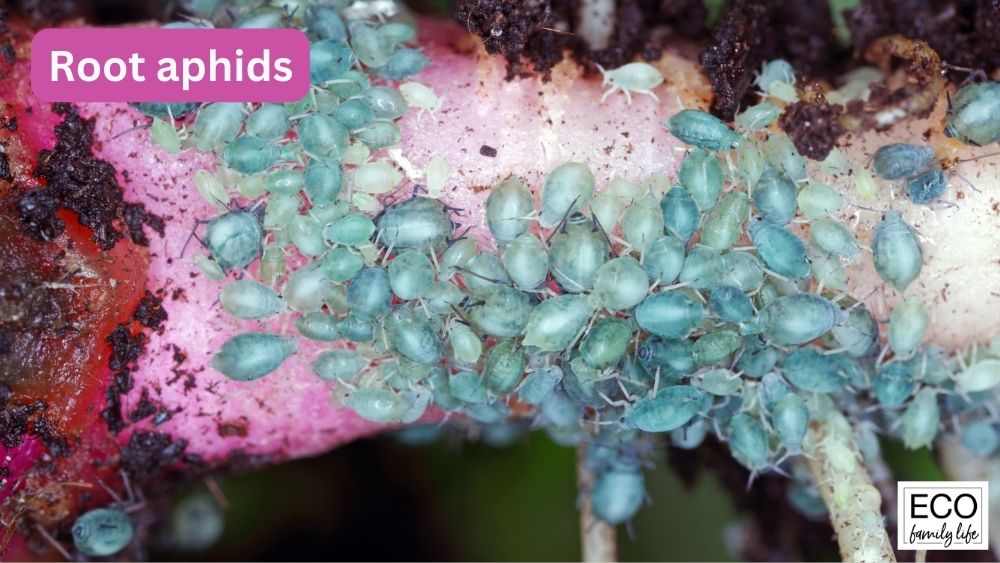Soil mites and root aphids are two common bugs. Soil mites are arachnids, they live in the soil and leaf litter and are generally beneficial. They feed on decaying matter and help to break down organic matter in your soil. Root aphids are insects, they live on plant root systems and feed on plant sap. They can harm and weaken your plants, causing the leaves to yellow, wilt and eventually can stunt plant growth. This article will explore the key differences between these two bugs and how to control them in your garden.

Key Takeaways
- Soil mites and root aphids are two common pests that can damage plants and soil.
- There are key differences between soil mites and root aphids, including their physical characteristics, habitat, feeding habits, reproduction, impact on soil and plants, and management and control methods.
- By understanding these differences, you can identify and manage soil mites and root aphids effectively.
Key differences between Soil Mites and Root Aphids
| Characteristic | Soil Mites | Root Aphids |
|---|---|---|
| Taxonomy | Arachnids (Acari) | Insects (Hemiptera) |
| Habitat | Soil and leaf litter | Plant root systems |
| Feeding Behavior | Predatory or Detritivores | Herbivorous |
| Diet | Feed on small organisms, decaying matter | Feed on plant sap |
| Impact on Plants | Generally beneficial, help control pests | Harmful, weaken plants |
| Appearance | Tiny, diverse species, often translucent | Small insects, various colors |
| Damage Symptoms | None or minimal, may improve soil health | Yellowing, wilting, stunted growth |
| Reproduction | Lay eggs, reproduce slowly | Reproduce rapidly, live birth |
| Control and Management | Not typically a pest, often beneficial | Requires systemic insecticides or biological control |
| Role in Ecosystem | Decomposers and beneficial predators | Potential pests affecting plant health |
Overview of Soil Mites and Root Aphids
While soil mites and root aphids may seem similar at first glance, there are several key differences between the two that are important to understand if you want to effectively manage and control them.
What Are Soil Mites?
Soil mites are tiny arthropods that live in soil. They are part of the tick and spider families and are so small that a microscope is needed to see them properly. Soil mites come in different colors, including brown and white, and grow to around 1-2 mm in diameter. They have eight legs and are usually less than 1mm in length.
Soil mites are generally considered beneficial for gardens because they help to break down organic matter in the soil, such as dead plant material, fungi, and microfauna. They are also important in maintaining soil structure and nutrient cycling.

What Are Root Aphids?
Root aphids are small, black insects that feed on the roots of plants. They are visible to the naked eye and can be found near the top of the soil, as well as on lower leaves and stems. Root aphids have a blunt head and lack wings, and they produce short yellow excretions.
Root aphids can cause significant damage to plants, as they feed on the plant roots, stem, and leaves. They can also transmit plant viruses and other diseases.

Physical Differences Between Soil Mites and Root Aphids
When it comes to distinguishing between soil mites and root aphids, there are several physical differences to look out for. In this section, we’ll take a closer look at the size and shape, as well as the color and texture of these two pests.
Size and Shape
One of the most obvious differences between soil mites and root aphids is their size and shape. Soil mites are much smaller than root aphids and are typically around 1-2 mm in diameter. They are also elongated in shape, with a narrow, pointed body.
Root aphids, on the other hand, are larger and more robust in shape. They typically measure around 2-3 mm in length and have a rounder, more compact body.
Color and Texture
Another key difference between soil mites and root aphids is their color and texture. Soil mites can be either brown or white and have a smooth, shiny texture. They are often difficult to see with the naked eye and require a microscope to properly observe.
Root aphids, on the other hand, are typically black in color and have a rough, textured exterior. They are much easier to spot than soil mites, and can often be seen crawling on the leaves and stems of plants.
Habitat and Distribution Between Soil Mites and Root Aphids
Soil Mites Habitat
Soil mites are commonly found in soil, on the soil surface and in leaf litter, where they feed on fungi, algae, and decaying organic matter. These tiny bugs can also be found in other habitats such as freshwater and marine environments, but they are most abundant in soil. Soil mites are found all over the world, from the tropics to the arctic regions.
Soil mites thrive in moist environments and are sensitive to changes in temperature, humidity, and pH. They are more abundant in soils with higher organic matter content, and they play an important role in the decomposition of organic matter and nutrient cycling in soil ecosystems.
Root Aphids Distribution
Root aphids are found in a wide range of habitats, including agricultural fields, gardens, and natural ecosystems. They are distributed worldwide, but their distribution is influenced by climatic conditions. In general, root aphids are more common in temperate regions than in tropical regions.
Root aphids are typically found on the root system of plants, where they feed on the plant’s sap. They can also be found on the stems and leaves of plants, but they are less common in these locations. Root aphids are often associated with plants that are stressed or growing in poor soil conditions.
Feeding Habits of Soil Mites and Root Aphids
Soil Mites Diet
Soil mites are known to be decomposers, which means they feed on decaying organic matter such as dead leaves, fungi, and bacteria. They play a significant role in maintaining the soil’s fertility by breaking down organic matter and releasing nutrients back into the soil. Soil mites are also known to feed on other small organisms such as nematodes, springtails, and other mites.
Root Aphids Diet
Root aphids are known to be sap-sucking insects that feed on the sap of plants. They insert their mouthparts into the plant’s roots and suck out the sap, which can lead to stunted growth, yellowing of leaves, and even death of the plant. Root aphids also secrete a sticky substance called honeydew, which can attract other insects and lead to the growth of sooty mold on the plant’s surface.
Root aphids are more likely to attack new plants, especially during their early stages of growth. This is because young, tender plant roots are tender and easier for the root aphid to pierce and feed on.
Reproduction and Life Cycle of Soil Mites and Root Aphids
Reproduction of Soil Mites
Soil mites reproduce sexually and lay eggs in the soil. The eggs hatch into larvae, which then develop into nymphs before reaching adulthood. Mites can reproduce rapidly in favorable conditions, with some species producing up to 20 generations per year. They require moist soil to lay their eggs, and the eggs can take anywhere from a few days to several weeks to hatch. Once hatched, the larvae feed on organic matter in the soil before molting into nymphs and eventually adults.
Life Cycle of Root Aphids
Root aphids reproduce asexually, meaning that they do not need a mate to reproduce. Females give birth to live young, and each offspring is a clone of the mother. This allows for rapid population growth particularly during warm seasons. Root aphids have a relatively short life cycle, with adults living for only a few weeks. During this time, they can produce several generations of offspring.
Impact of Soil Mites and Root Aphids on Soil and Plants
When it comes to the impact of soil mites and root aphids on soil and plants, there are some key differences to consider.
Soil Mites Impact
The good news is that soil mites can actually be beneficial for soil health. They help to break down organic matter and release nutrients, which can be beneficial for plant growth. However, if the population of soil mites becomes too large, they can start to compete with plants for nutrients, which can lead to stunted growth and nutrient deficiencies.
Some species of soil mites can also be predators of other soil-dwelling pests, such as predatory nematodes and other mites. This can help to keep the population of these pests in check, which can be beneficial for plant health.
Root Aphids Impact
Root aphids, on the other hand, can have a much more negative impact on plants. They feed on the roots of plants, which can lead to reduced growth and even death in severe cases. Root aphids can transmit plant viruses, which can further damage plant health.
One of the key challenges with root aphids is that they can be difficult to detect. By the time you notice symptoms of a root aphid infestation, such as wilting or yellow leaves, the population of root aphids may already be quite large.
Management and Control of Soil Mites and Root Aphids
Controlling Soil Mites
If soil mite populations are getting out of control, particularly on your indoor plants, here are some easy ways to control them.
- Keep the soil moist: Soil mites thrive in dry soil, so keeping the soil moist can help control their population.
- Use predatory mites: Predatory mites are natural enemies of soil mites and can be used to control their population.
- Remove organic matter: Soil mites feed on organic matter, so removing the organic matter can help control their population.
- Use insecticidal soap: Insecticidal soap can be used to control soil mites. However, it is important to use it as directed to avoid harming beneficial insects.
- Diatomaceous earth can help control certain soil-dwelling pests, including some types of soil mites, by causing physical damage to their exoskeletons as they crawl through the sharp particles. However, it may not be as effective against all species of soil mites, especially those that are better adapted to surviving in soil.
Managing Root Aphids
Root aphids can be difficult to control, but there are some effective ways to manage their population. Here are some methods to consider:
- Use beneficial insects: Beneficial insects, such as ladybugs and lacewings, are natural enemies of root aphids and can be used to control their population.
- Use neem oil: Neem oil is a natural insecticide that can be used to control root aphids. However, it is important to use it as directed to avoid harming beneficial insects.
- Remove infested plants: If a plant is heavily infested with root aphids, it may be best to remove it to prevent the infestation from spreading.
- Use sticky traps: Yellow sticky traps can be used to monitor the population of root aphids and can help control their population.
It is important to note that prevention is key when it comes to managing soil mites and root aphids. By maintaining healthy plants and a healthy soil ecosystem, you can reduce the likelihood of an infestation. Early detection is key and treat as soon as you notice these tiny creatures attacking your plants.
Conclusion
Soil mites and root aphids are two distinct pests that can harm your plants in different ways. While soil mites are generally beneficial for the soil, some species can become a nuisance and damage your plants. On the other hand, root aphids feed on your plant’s sap and can cause significant damage to the roots, leading to stunted growth and even death.
By understanding these differences, you can identify the pest affecting your plants and take appropriate measures to control them.
It is essential to note that the presence of soil mites or root aphids does not necessarily mean your plants are doomed. With proper care and management, you can prevent infestations and keep your plants healthy.
If you suspect that your plants are affected by root aphids in particular it is important to act quickly. Monitor your plants regularly, inspect the leaves and roots, and take appropriate measures to control the pests before they cause irreversible damage.
Frequently Asked Questions
What are the different types of soil mites?
There are several types of soil mites, including oribatid mites, mesostigmatid mites, and prostigmatid mites. Oribatid mites are the most common type of soil mite and are usually found in the top layer of soil. Mesostigmatid mites are predatory mites that feed on other mites and insects. Prostigmatid mites are also predatory and feed on other mites, but they are typically found in damp soil.
How can beneficial soil mites be identified?
Beneficial soil mites can be identified by their behavior and appearance. They are usually small and light-colored, and they move quickly through the soil. They also help to break down organic matter and improve soil structure. If you see small mites moving quickly through the soil and breaking down organic matter, they are likely to be beneficial soil mites.
What are the key differences between soil mites and fungus gnats?
Soil mites and fungus gnats can be easily confused because they are both small and found in soil. However, there are some key differences. Soil mites are usually light-colored and move quickly through the soil. Fungus gnats, on the other hand, are dark-colored and have long legs. They also have wings and can fly. Fungus gnats are also attracted to light, while soil mites are not.
What are effective methods for getting rid of root aphids?
There are several effective methods for getting rid of root aphids, including using insecticidal soap, neem oil, or predatory insects like ladybugs or lacewings. You can also try using beneficial nematodes, which are microscopic worms that feed on root aphids. It is important to treat root aphids as soon as possible to prevent them from spreading and causing further damage to your plants.
How can root aphids be identified?
Root aphids are small, black insects that feed on the roots of plants. They can be identified by their blunt head and lack of wings. They also produce short yellow excretions. If you notice your plants are wilting or have stunted growth, it may be a sign of root aphids.
What is the difference between spider mites and soil mites?
Spider mites and soil mites are both small, but they have some key differences. Spider mites are usually red or brown in color and are found on the leaves of plants. They spin webs and can cause damage to the leaves. Soil mites, on the other hand, are usually light-colored and are found in the soil. They help to break down organic matter and improve soil structure.
I am an accredited practicing dietitian, experienced gardener and a dedicated cook. I love writing and sharing my experience so you can learn from my successes and mistakes.
